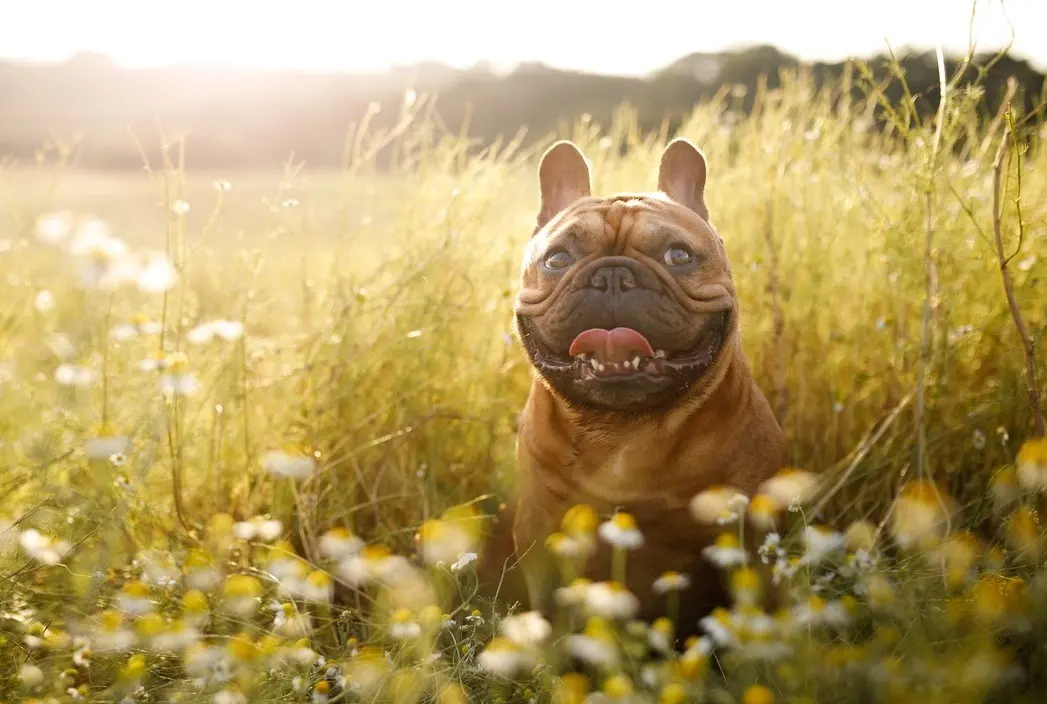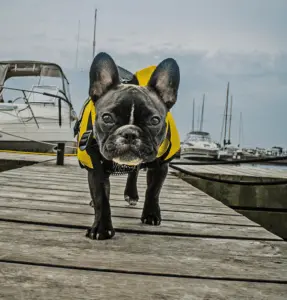Are you part of the French [bulldog] Revolution? This bat-eared breed has captivated American hearts and soared to the top of the American Kennel Club’s 2022 registration list, ending the Labrador retriever’s 31-year reign as America’s most popular dog.
However, these wrinkled wonders should come with a warning label. The French bulldog’s unique features put them at risk for heat-related emergencies and other dangers. Here’s how to keep your canine companion from becoming a hot dog this summer.
Cute but endangered: How your French bulldog’s structure affects their safety
The French bulldog’s compact and sturdy shape make them look tough and impressive, but the stout body and shortened snout create several summer safety concerns.
The French bulldog’s large brachycephalic skull and flat muzzle create a collection of respiratory abnormalities known as brachycephalic obstructive airway syndrome (BOAS). Their small trachea (i.e., windpipe), narrow nostrils, and elongated soft palate can obstruct normal breathing and affect their ability to pant and cool themselves.
Airway restriction and air flow resistance can cause audible snorting, snoring, and noisy breathing that when severe, can trigger panic. Then, their tongue and palate can swell because of the excessive panting and respiratory effort, resulting in strangulation.
The French bulldog’s barrel-shaped chest, large head, and short legs also impair their ability to tread water, so they are poor candidates for summer swimming and water-based activities.
Too hot to handle: When is hot too hot for your French bulldog?
There is no hard and fast rule about an unsafe temperature for dogs. Generally, use caution and significantly limit your French bulldog’s outdoor activity when the mercury rises above 80 degrees. Use extreme caution during excessive heat (e.g., 90 degrees and above or high humidity index) and keep your French bulldog indoors except to eliminate. On the other hand, some French bulldogs are less heat-tolerant and will need to stay indoors on mild 70-degree days.
The “X” factor: How overexcitement affects your French bulldog’s health
French bulldogs are a fun-loving breed, but they don’t always know how to pace themselves or when to quit. Overexcitement can worsen heat-related challenges and increase heatstroke risk.
Keep your French bulldog as calm as possible during warm weather and minimize stimuli that may trigger excessive excitement.
Heat warning: How to recognize heat distress in your French bulldog
In a perfect world, you’ll never have to witness your French bulldog experience heat stress. However, all Frenchie owners should learn to recognize heatstroke signs to ensure rapid intervention and a full recovery from this potentially fatal emergency.
From mild to severe, progressive heatstroke signs include:
- Heavy, rapid, or excessive panting
- Rapid heart rate
- Drooling
- Vomiting or diarrhea
- Loss of coordination
- Lethargy
- Mental dullness
- Discolored tongue or gums (e.g., brick red, blue, purple, or grey)
- Collapse
- Seizures
- Unconsciousness
If your dog experiences mild heat distress signs, take them to an air-conditioned area, offer cool drinking water, and apply cool, wet towels to their abdomen and paw pads. Dogs with more progressive signs, such as weakness or collapse, should be immediately transported to an emergency veterinary hospital.
Land lover: Protecting your French bulldog around water
French bulldogs are adventurous and bold companions, but their low and heavy build makes them no match for water-based activities.
If your French bulldog will be in or around water (e.g., pool, lake, pond, river, ocean) ensure they always wear a well-fitted life-jacket to increase their buoyancy, minimize their swimming efforts, and prevent accidental drowning should they fall or become fatigued. The life jacket should have a top handle, so you can safely pull your pet from the water or prevent them from needless splashing.
Finally, do not allow your thirsty French bulldog to drink from unlikely or unappealing sources, such as lapping from ponds or lakes that may have bacteria and algae. Ensure they drink only fresh human-grade water to prevent toxicity.
Frosty paws: Preventing summer emergencies in French bulldogs
French bulldogs are a special breed whose owners are always willing to go to extra lengths to ensure their absolute safety. Fortunately, they can be protected without sacrificing their summer fun. In hot weather, you should:
- Check the weather — Don’t be surprised by toasty temperatures. Check your local weather before venturing outdoors.
- Provide shade and water — Always ensure your dog has access to fresh water and shade.
- Supervise — Never leave your dog unattended outdoors or in a parked vehicle.
- Exercise indoors — Train your French bulldog to walk on a treadmill, sniff out hidden treats, or set up a living room obstacle course.
- Limit outdoor access — Restrict outdoor activity to early mornings and late evenings when the temperatures are cooler. Walk shorter distances more slowly.
- Avoid hot pavement — Asphalt can reach searing temperatures during the day and burn your dog’s paw pads.
- Use cooling mats, coats, and bandanas — These are great methods for helping your dog stay cool, but they should never replace close observation or treatment for a dog suffering from heatstroke.
French bulldogs are comical, cuddly, and “ruff”-and-tumble companions, but they are not immune to summer hazards. If your French bulldog’s summer goes sideways, UrgentVet is ready to help with any unexpected but non life-threatening need. Contact an UrgentVet location near you, because your hot Frenchie needs cooling down fast.






